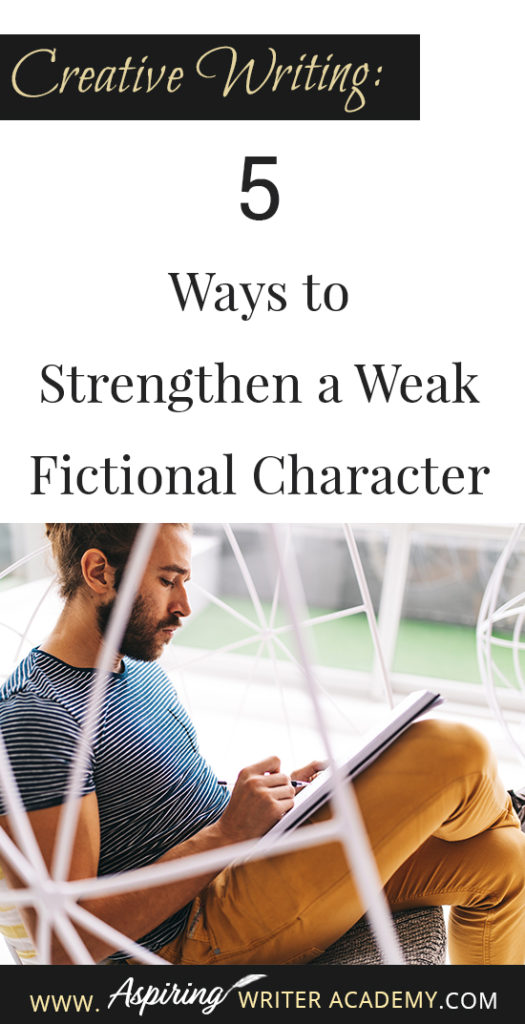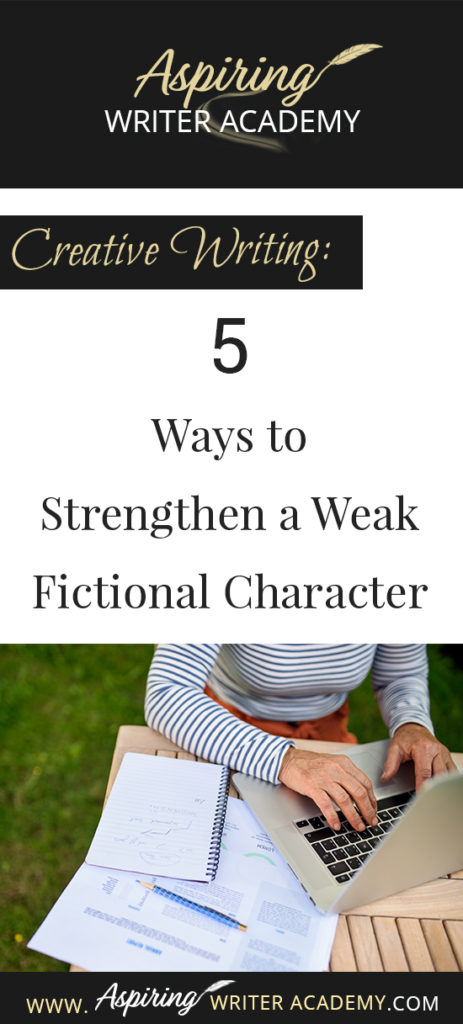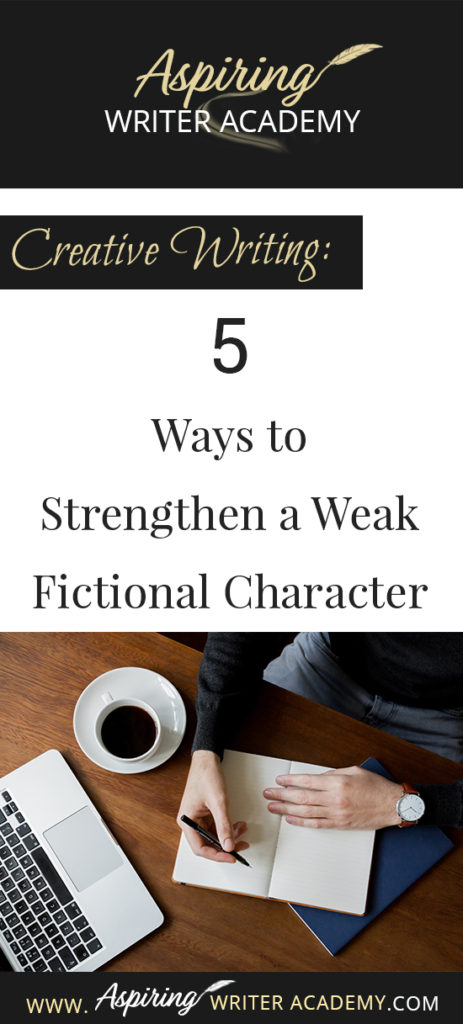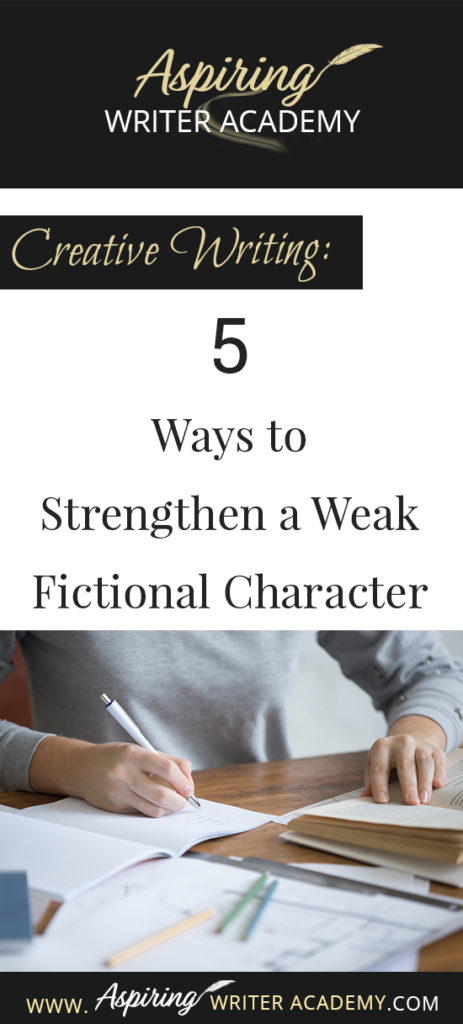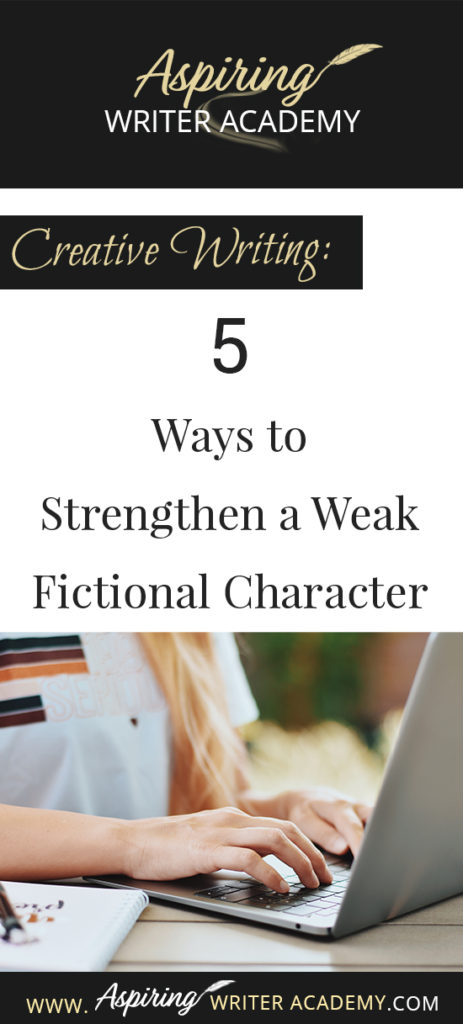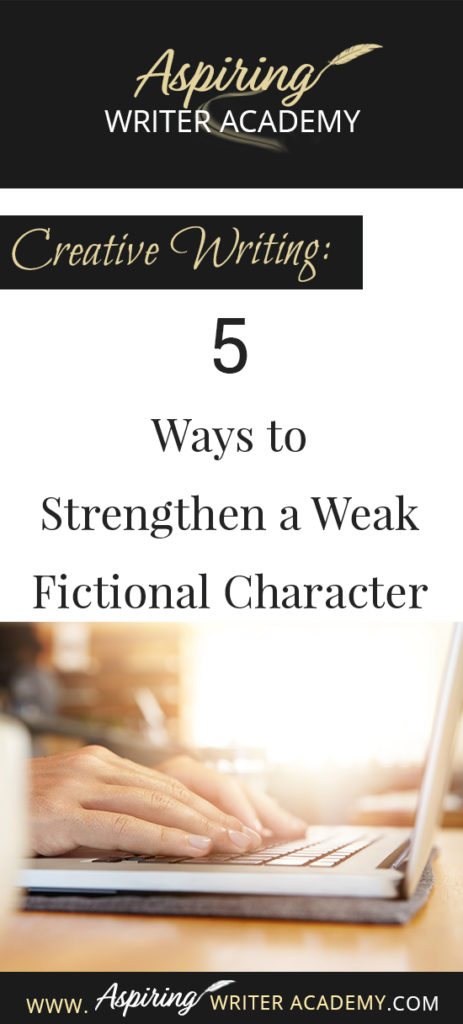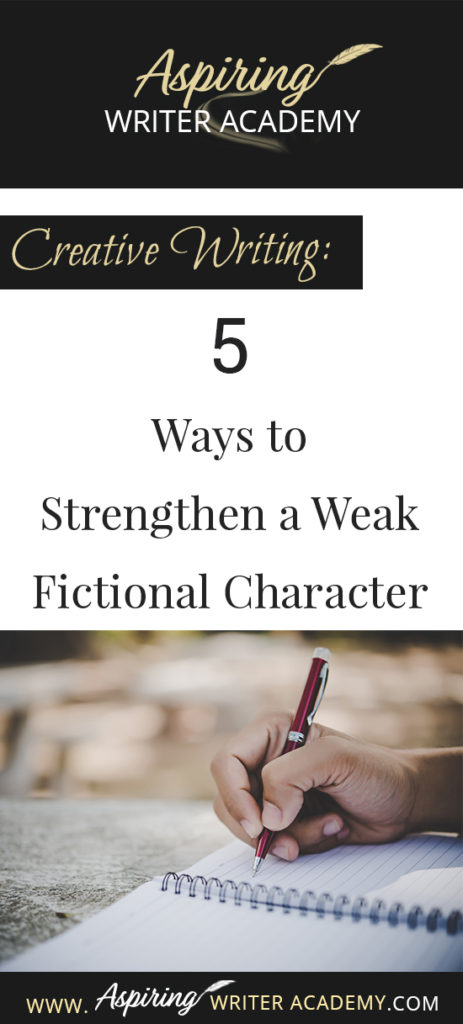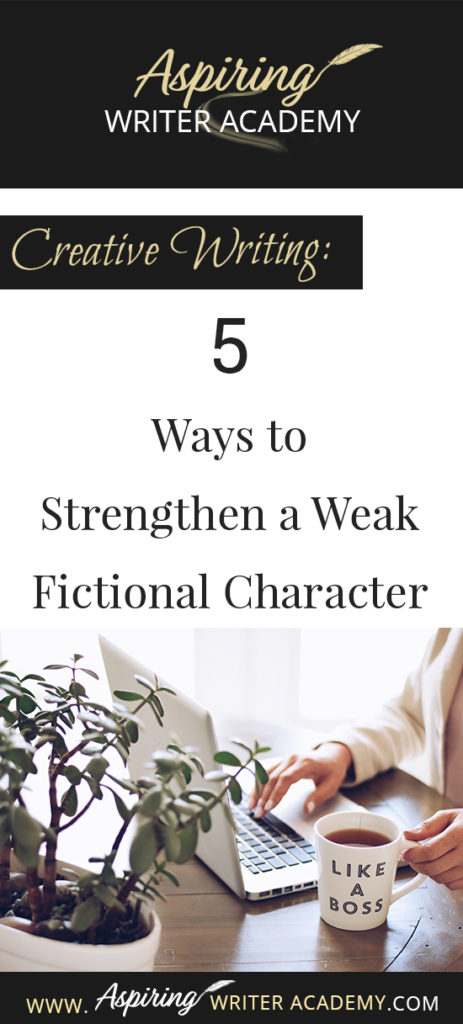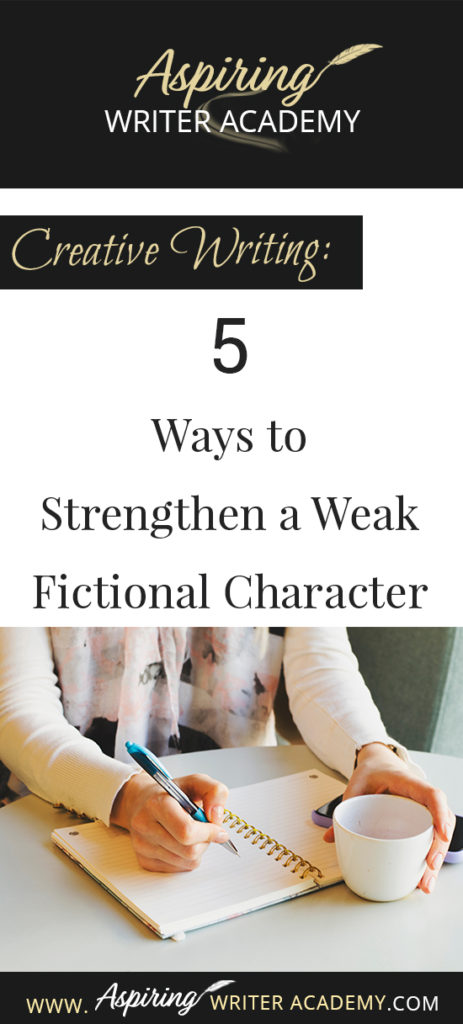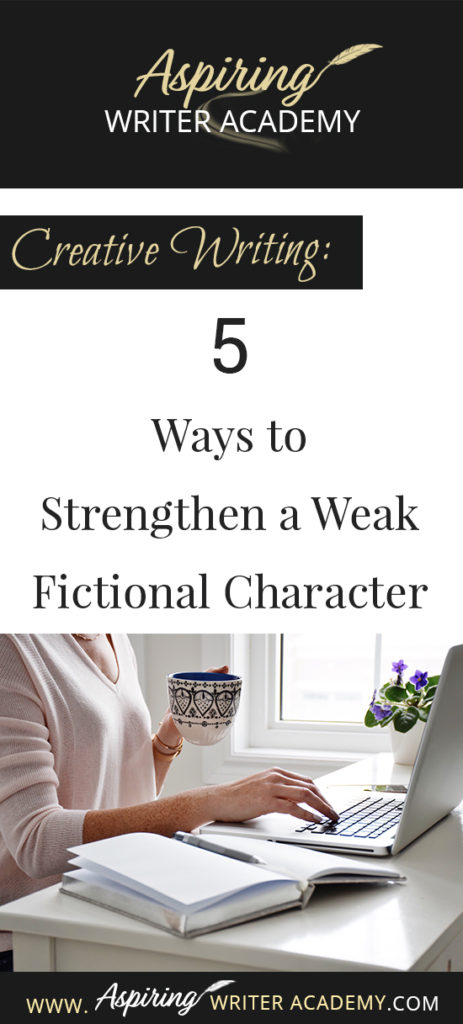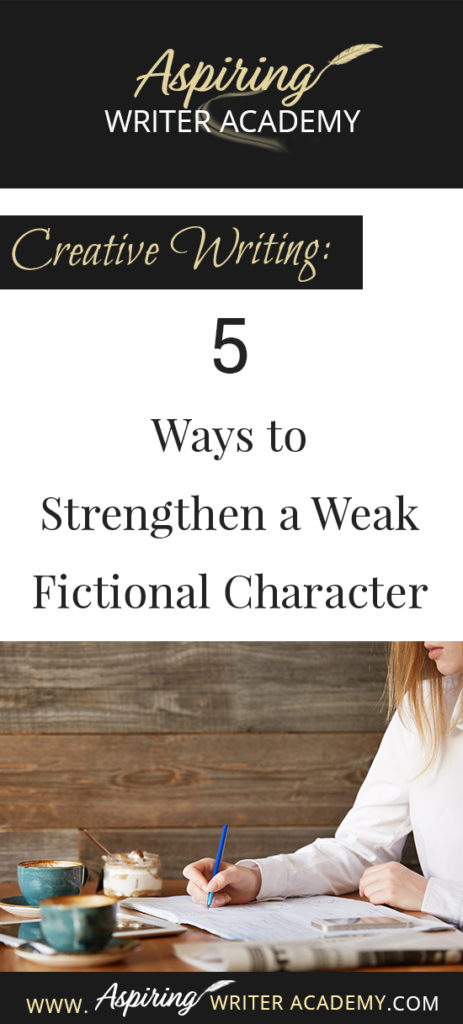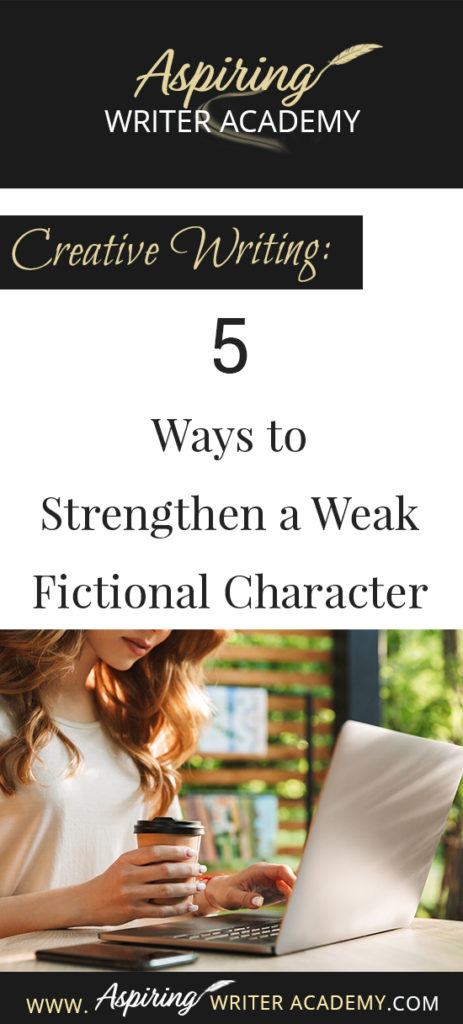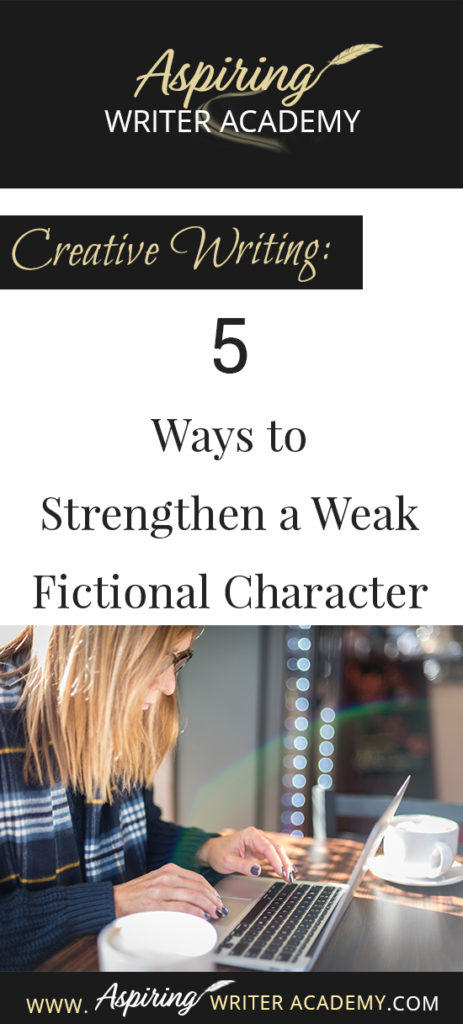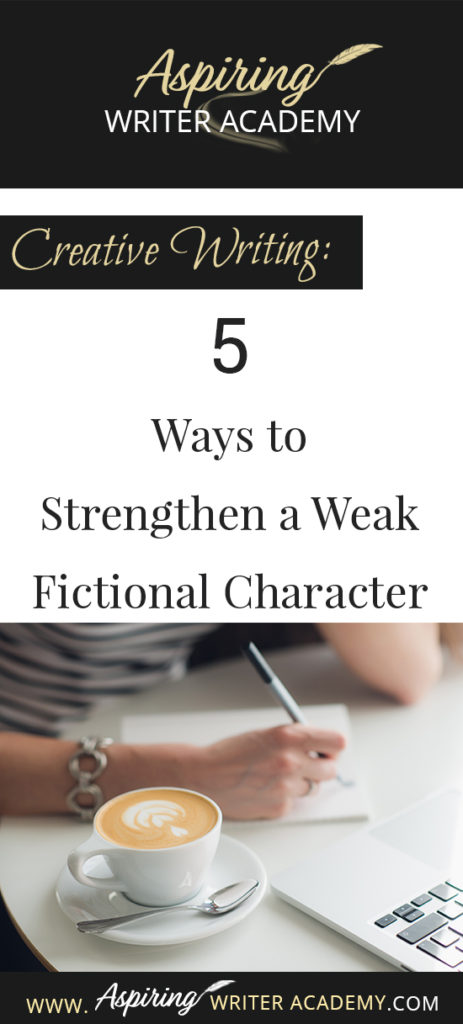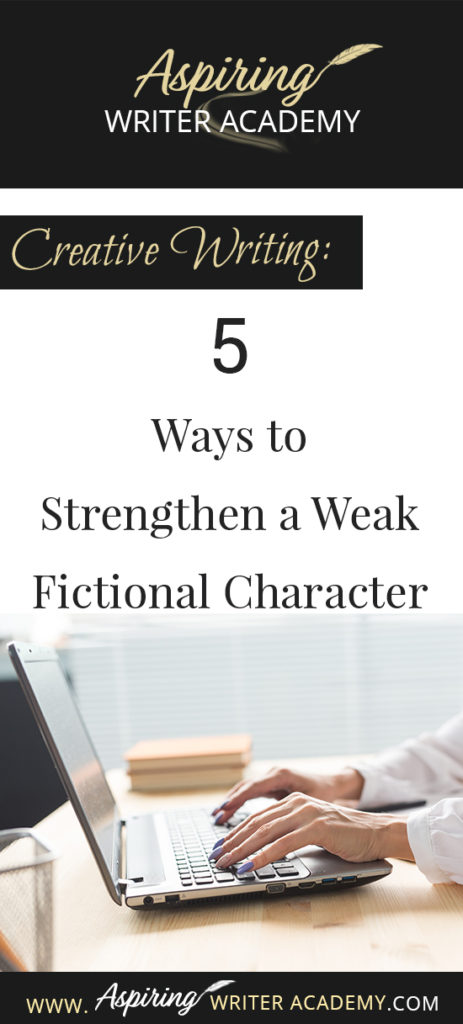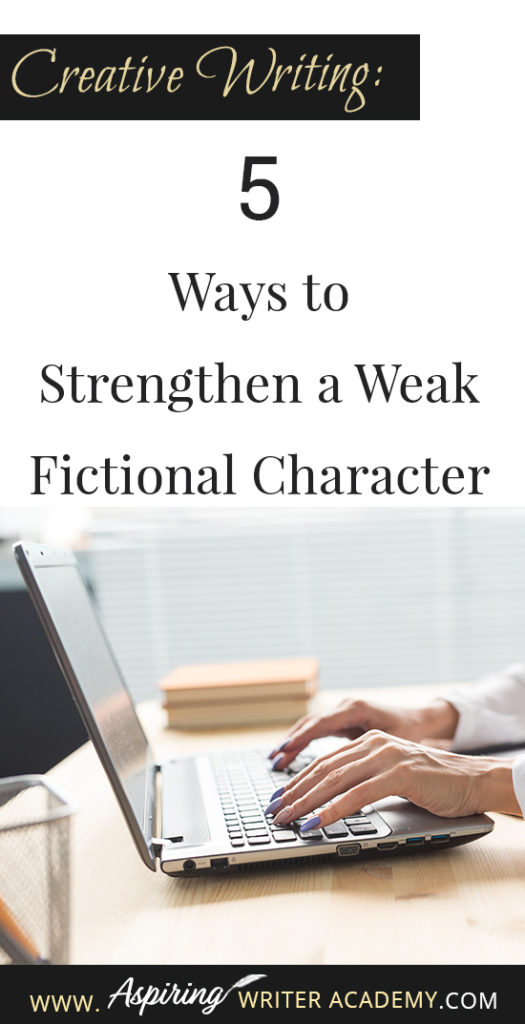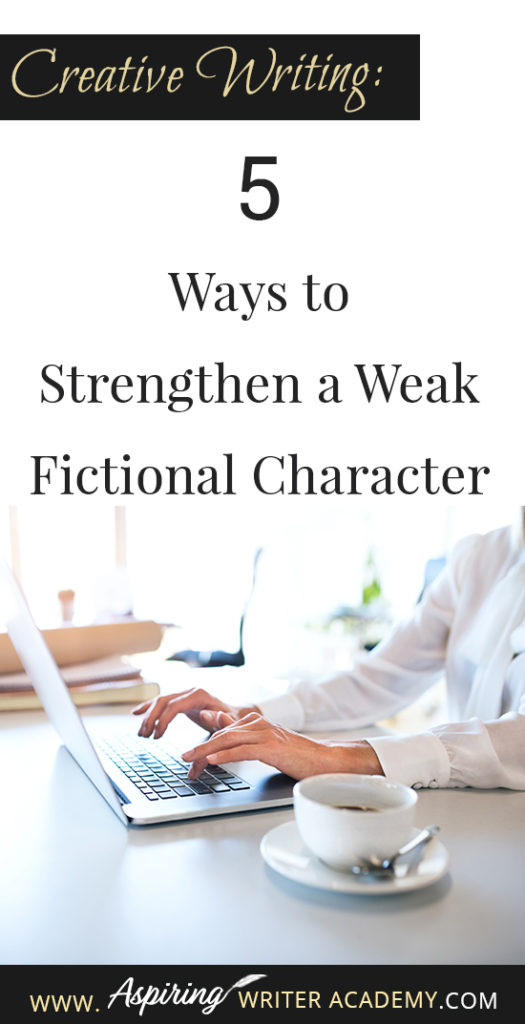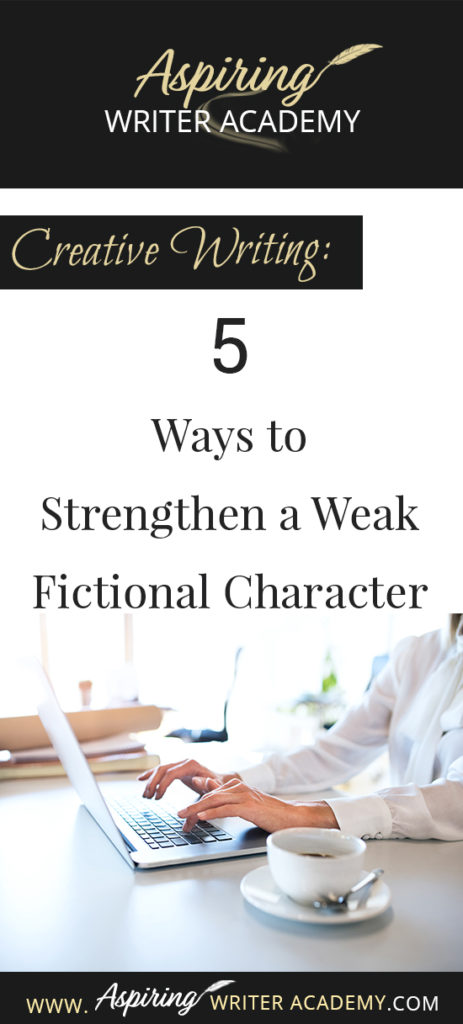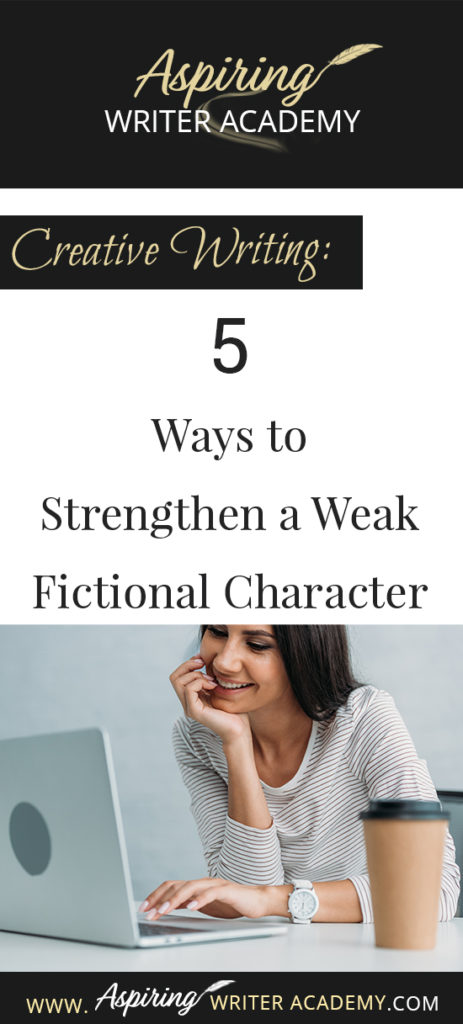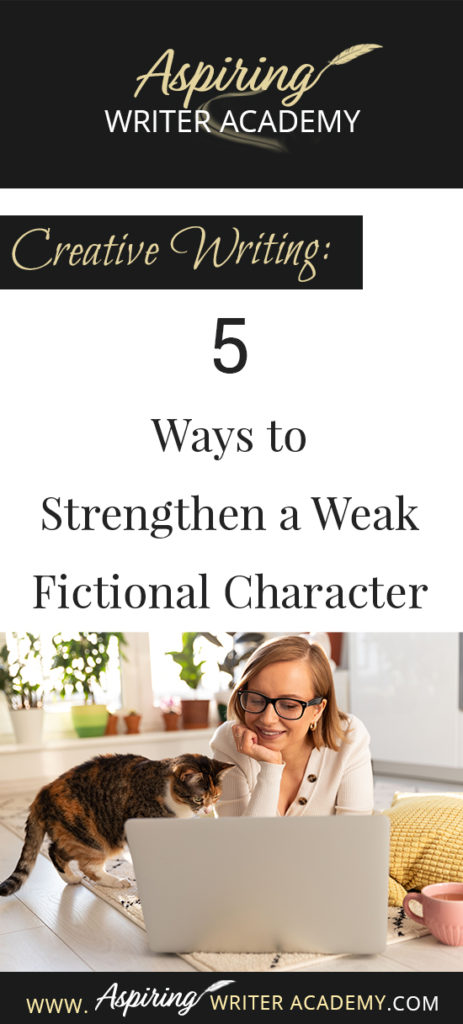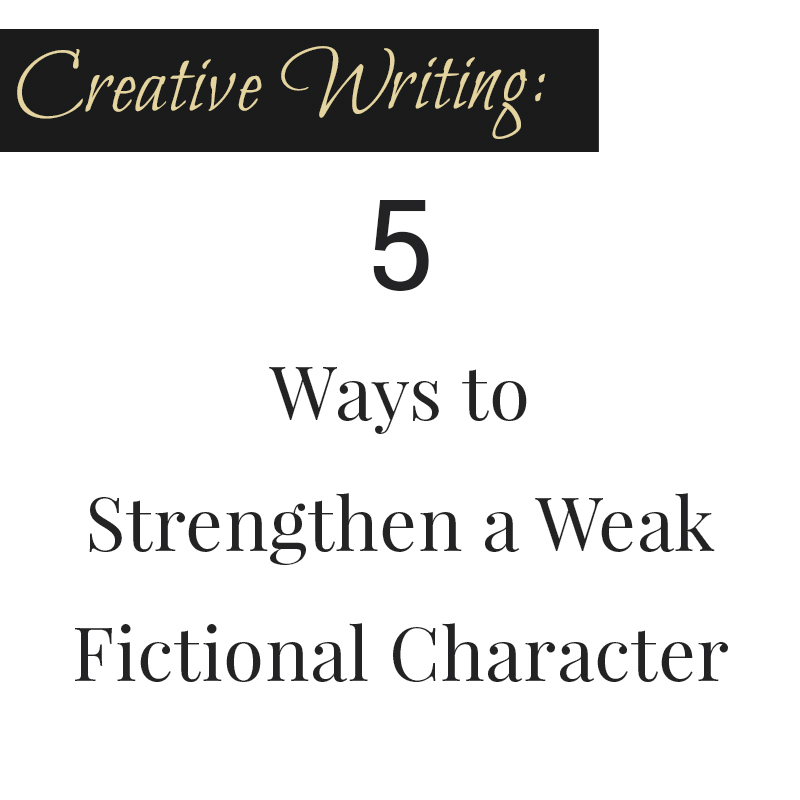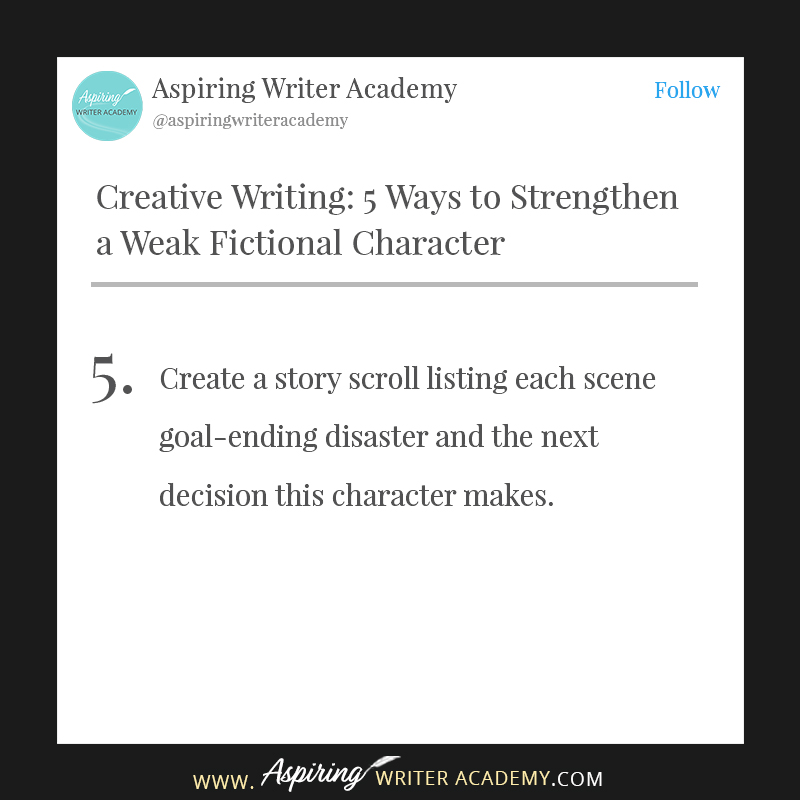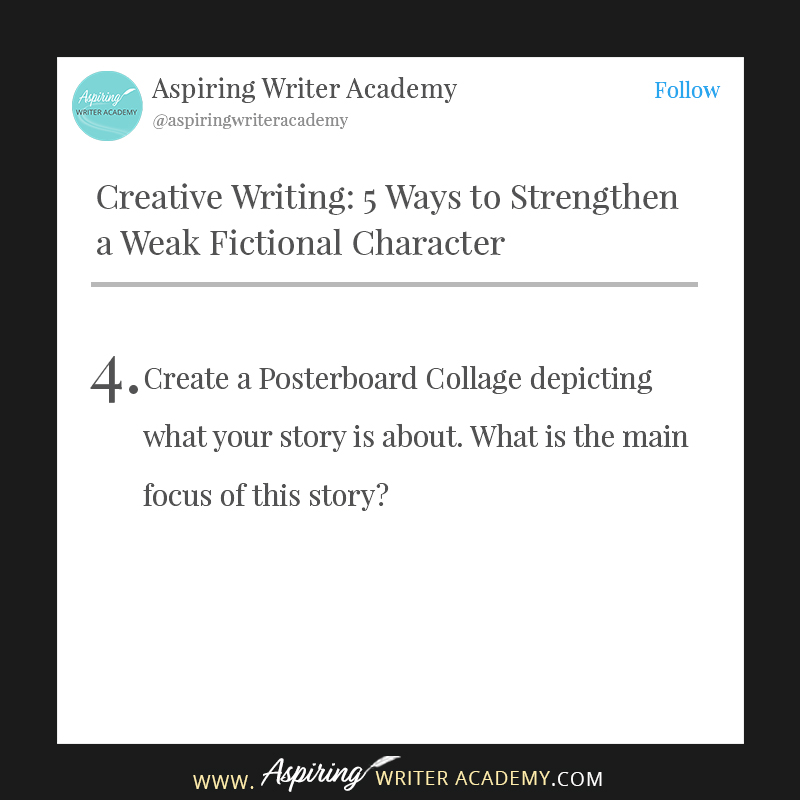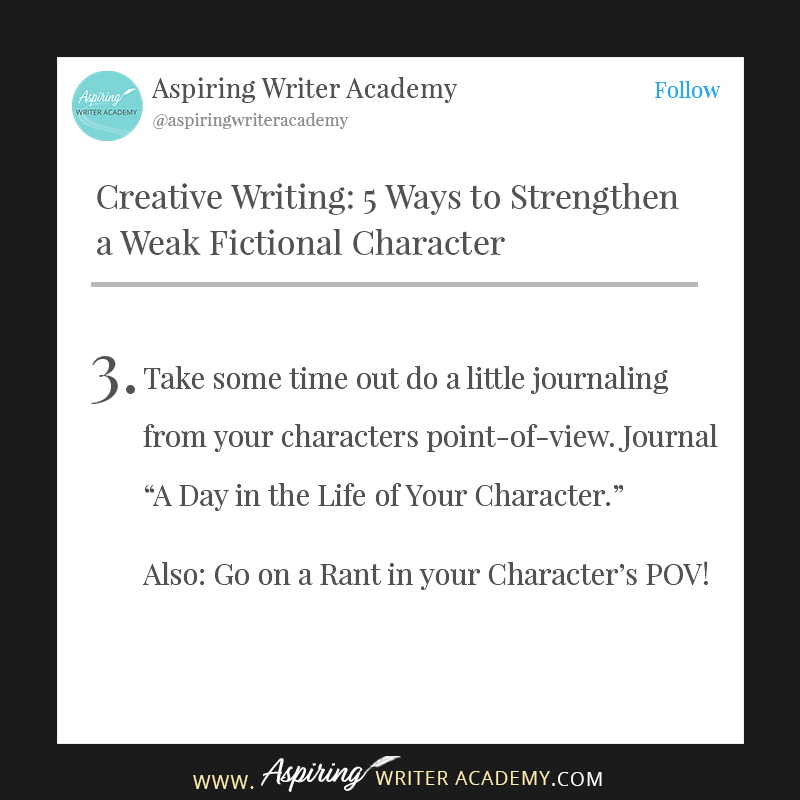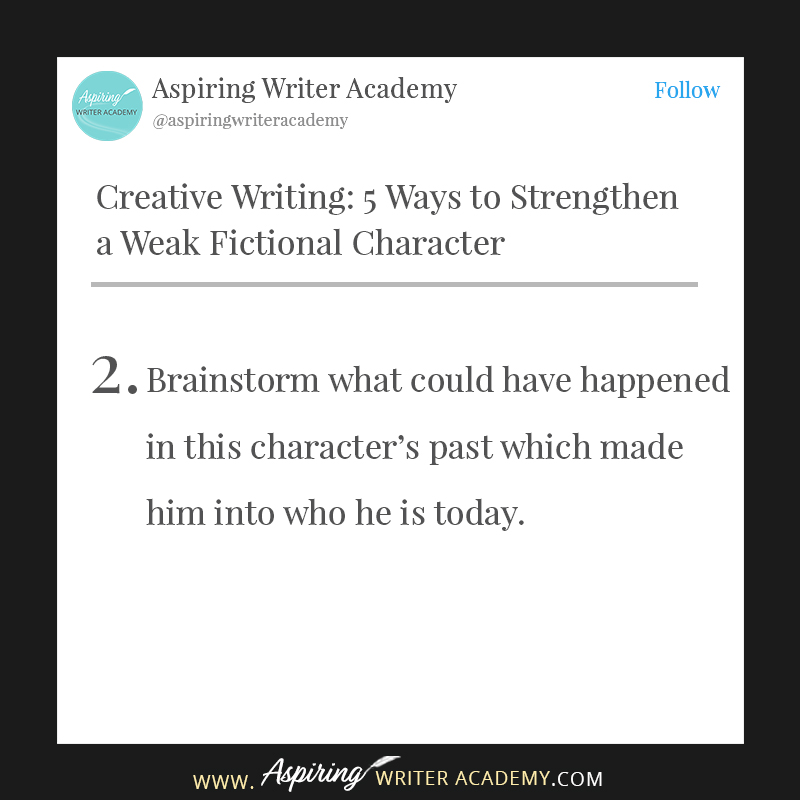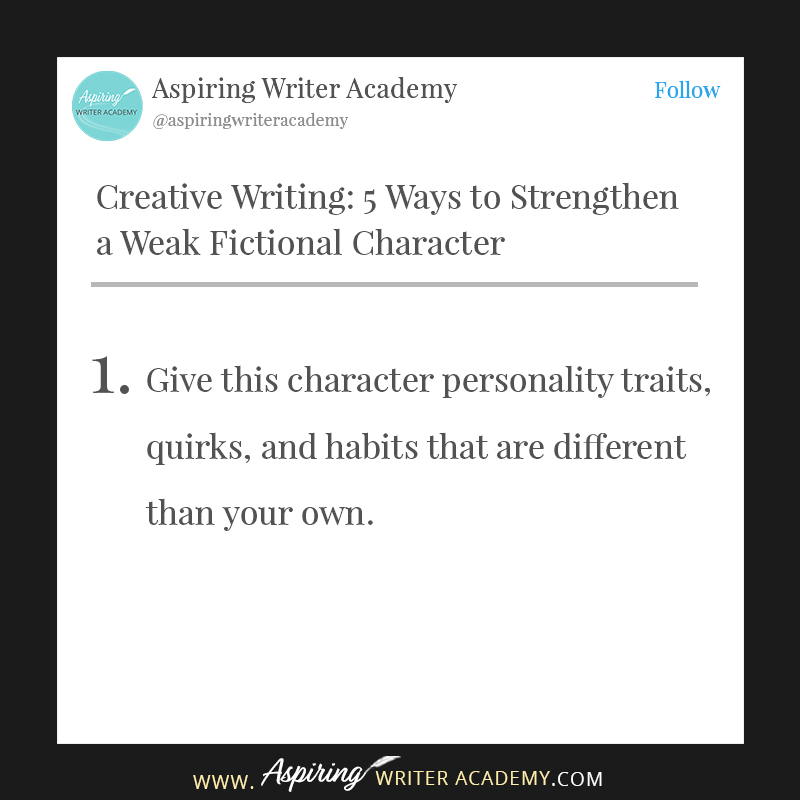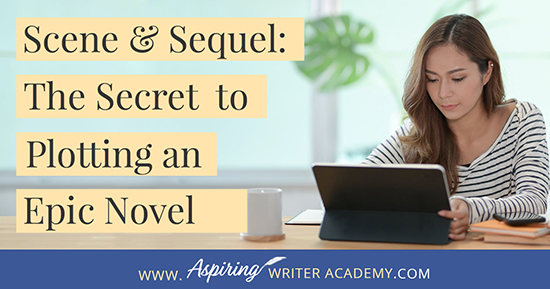Creative Writing: 5 Ways to Strengthen a Weak Fictional Character
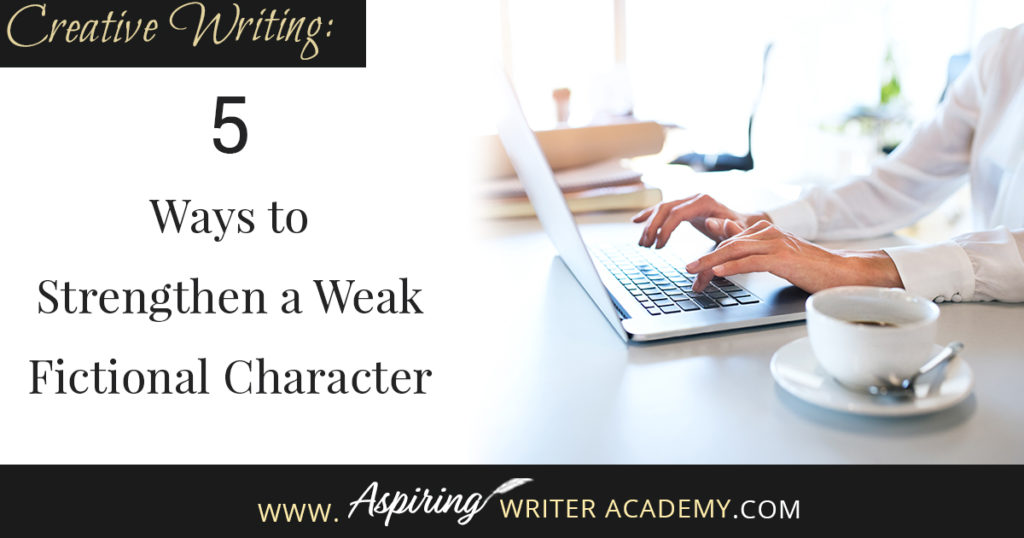
Do you have trouble writing strong fictional characters?
Perhaps you have been told that your protagonist or antagonist or a sub-character is weak, that they need more motivation. Perhaps the character doesn’t have a strong enough story goal, or enough personality or maybe the character isn’t actively driving the story forward.
How can you “fix” a weak character and make him worthy? Follow along as we discuss, Creative Writing: 5 Ways to Strengthen a Weak Fictional Character in the post below.
Often when you ask a critique partner, editor, agent, beta reader, or even a trusted friend to read over your manuscript and give you honest feedback, you are already feeling vulnerable, wondering what they will say.
The anxiety becomes worse, when their suggestions for revision leave you with questions that you do not know how to answer.
You may be thinking: How do I fix this?
Characters drive the story forward with their decisions, actions, and motivation.
If a main character is not as strong as they need to be, there is a good chance the rest of the story will not be as strong as it could be either. Everything interconnects.
In the post below we will discuss tips for strengthening:
- Character Identity & Personality Traits
- Backstory & Motivation
- Revealing Emotion
- Goals and Actions vs. Reactions
- Decisive Decisions
1) Character Identity & Personality Traits
If someone has told you that your character is ‘weak,’ then the first thing you should do is sit back and try to find out why. Especially, if this is a recurring problem with each of your stories.
Example: You may be fantastic at writing strong, decisive, well-motivated heroes, but you may struggle when it comes to writing scenes from your heroines point-of-view. Or vice-versa.
So you must ponder: Why do you think this is?
Could it be that you are just too close to your heroine? Are you writing her scenes as if she were you? Perhaps too many of her thought processes and personality traits are in your head and it’s not making it to the written page?
Or perhaps the problem is that you just do not know this character well enough?
Solution #1: Give this character personality traits, quirks, and habits that are different than your own.
Use the Meyers-Briggs personality test to create your character’s personality.
https://www.16personalities.com/free-personality-test
Or get yourself a copy of a fantastic resource, a book called, “Linda Goodmans Sun Signs,” by Linda Goodman.
You don’t have to believe in astrology to use this book for your writing. Inside, you will find complete lists of character personalities with quirks, habits, and details on how this type of character would relate to others in all kinds of different relationships and situations.
Simply pick a personality type and use it for your character. So easy!
Shop on Amazon: https://amzn.to/3cOkM4W
Another great resource is a book titled, “Believable Characters: Creating with Enneagrams,” by Laurie Schnebly Campbell.
Similar to the Meyers-Briggs Personality test, and the Sun Signs book, this book profiles 9 different personality types and how they interact with others, make choices, along with their strengths and weaknesses.
Personally, I love using the Enneagram chart when I am brainstorming my characters! You can grab your own copy at:
Shop on Amazon: https://amzn.to/3oE12na
It might also help if you think of a real person and borrow some of their personality traits, quirks, and habits. Perhaps take the habits of two people you know and put them together in one of your characters. Or combine the traits of three people that you know.
Or take a few personality traits and habits from someone you see on TV or in a movie and incorporate them into your character.
A concrete image of someone else in your mind may give you a better visual of what kind of character you are writing. You can also cut pictures of people out of magazines and imagine what kind of character they may be. Use the pictures to create a “Character Card” and list details about your character.
Go to the coffee shop or other public place and watch how people act. What do you notice about how they talk, walk, and engage with others? What do they do with their hands? How does their clothing and hairstyle hint at what kind of person they are?
Can you borrow some of their traits for your character?
If you do use another person as a model, be careful that you do not describe him detail for detail, turning him into an exact replica. You do not want to have your character represent a real person like your mom, grandma, cranky old uncle, or a Hollywood figure who may recognize themselves and take offense!)
Find a way to make your characters different, combine traits from two people if you must, but make your character unique.
2) Backstory & Motivation
Many times, an author may flounder when writing one of their characters because they do not know the character’s backstory. The character’s past experiences help form his beliefs and reactions, and impacts who your character is now.
Solution #2: Brainstorm what could have happened in this character’s past which made him into who he is today.
Can you think of a specific event?
Did something happen in his childhood that delivered a specific wound this character must overcome? Something that still haunts him? Is there some childhood trigger that they cannot forgive or forget (even if they thought they’d forgiven and let it go?)
How could this hang-up or wound hinder his ability to achieve his goal in this present story?
Example: The hero’s mother walked out and left him when he was young, and he has had trouble trusting others in relationships ever since. This makes his life difficult when he is forced to work alongside a woman he is attracted to.
What must he learn to grow and put his past behind?
The events in the current story should force the character to come face to face with his disillusioned belief, bad habit, hang-up, or wound. The character should take positive steps to overcome this wound until the Black Moment three-quarters of the way through the story, when he fears all is lost.
How can his old ways of thinking or reacting rise up to haunt him at this moment and cause him to stumble in his quest to achieve the story goal?
Example: The hero who had his mother leave him as a boy, has slowly learned to trust the woman he is working with and hopes to marry. However, when she disappears, he fears that she too has left him, and he fears it is because he is unlovable and that he was a fool to ever allow himself to hope they might have a future together.
(Of course, she may have disappeared because she was kidnapped by the villain, but at this point the past rises to haunt the hero affects the way he reacts to the situation. In the next scene he may discover information to show him that he was wrong, and the heroine did not leave of her own accord.)
However, the idea here is that whatever happened in his past should also affect who he is now and cause conflict for him as he pursues the story goal. What must this character learn by the story’s end? How can overcoming his past help him defeat the current opposition or story problem and allow him to achieve his story goal?
What can he do now that he couldn’t do before? How has letting go of the past set him free?
3) Revealing Emotion
Sometimes the problem with a weak character is that the author does not know how this character thinks or feels. You may have no idea how or why a character would react in a certain situation.
Solution #3: Take some time out do a little journaling from your characters point-of-view. Journal “A Day in the Life of Your Character.”
Start in your character’s point-of-you and journal as if they are writing or telling someone else about their day.
- What is the first thing they do when they wake up? How do they feel? What do they eat and why? What are their likes and dislikes? Is there a reason for their specific tastes?
- What do they wear? Why do they prefer some clothes over others? For comfort? Style and appearance to impress others? Keep asking why?
- Use the 5 Senses: What does your character see, hear, smell, taste, or feel (touch) during his day? How does he or she feel about these things?
- What is difficult for your character this day? Which things are easy?
- What stirs their emotions? What do they care about and why? Does it tie in with someone they know or a situation from their past?
- Do they go to work? How do they spend the rest of their day? Do they visit others? Who do they meet? Do they like or dislike these people? Why?
Go on a Rant in your Character’s POV!
Now—take someone they meet who infuriates them and have your character go on a rant on why they do not like that person. Or why they disagree with the other person’s beliefs.
Let this be a very opinionated piece! Hold nothing back!
Describe what that other person looks like from head to toe and how they act and what about that person your character dislikes. Why does your character disagree with him? How does the other character anger him? Why?
Let the emotions flow over the page. You will be surprised at what you come up with.
(Set a timer for 10 minutes and write as fast as you can and do not stop to think – just write!)
Can you use some of this for your story?
Can you go on a rant to discover how your character feels during other parts of your story? What if instead of a rant, your character gushed over something they love?
How can your characters make decisions based off their thoughts and feelings?
4) Goals and Actions vs. Reactions
Sometimes the reason a character appears weak is because they have weak goals. The protagonist must be a character of action and not just reaction. This character must be the one who drives the story forward with actions and decisions. If he or she doesn’t have a story-worthy goal, that character will have very weak scene goals. The character, the scenes, and this story will seem passive with not much going on, at least not much that truly matters.
For additional information on how to create story-worthy goals, see https://www.aspiringwriteracademy.com/why-your-characters-need-story-worthy-goals/
At the beginning of the story, your main character (the protagonist) should be presented with a serious problem he or she must overcome by the story’s end. What the character decides to do to overcome this problem becomes his story-worthy goal. Achieving the goal to overcome this problem should take several action-plan steps. Each scene goal should focus on a step toward achieving the story-worthy goal.
Does your protagonist have a story-worthy goal? Does this character enter into each of his scenes intent on achieving a step forward toward reaching this goal? Or is your character just going around chatting with everyone and reacting to events and disasters caused by other people who seem to want to make life hard for him?
The character should enter into each scene with purpose and intention. They are actively trying to accomplish something. Each scene and each step forward should relate to the next.
If you have trouble lining up your scenes, you may want to learn more about Scene and Sequel, https://www.aspiringwriteracademy.com/scene-sequel-the-secret-to-plotting-an-epic-novel/
Perhaps at this point you will find that you really do not know what your story is about. If that is the case, then you might want to create a posterboard collage.
Solution #4: Create a Posterboard Collage depicting what your story is about. What is the main focus of this story?
Collect images from magazines or print them out from online sources and paste them on a posterboard. What ideas would you like to incorporate or explore in this story?
Where does the story take place? What are some of the character professions? What are the themes in your story? Paste any picture or phrases or words that you think may relate to your story.
Instead of a posterboard, you can also create a Pinterest board to help you collect all of your story ideas into one place.
Example: Let’s say your story is about firefighters. Cut out a picture of what you imagine your characters to look like and paste photos of firefighters working to put out a blaze. Sometimes the images you paste from newspaper articles and other resources will give you additional ideas for your scenes. What details do you notice in the background? How could you work that into your story? Which phrase from a newspaper clipping about wildfires catches your interest? Which specific details?
A posterboard collage forces you to focus and gives you a visual that you can also display for your readers at book signings.
Example Posterboard

5) Decisive Decisions
At the end of each scene the character either achieves his scene goal or he doesn’t. The scene-ending should present your character with a choice. He can now either do this or do that. Narrow it down to only two choices.
Weak choices do not move the story forward or give the character that next step to actively achieve their story goal.
Two choices: one decision that leads them to next scene goal.
If the character went into the scene with a specific goal to achieve, then the scene-ending should answer the question: Did the character get what he wanted? Did he achieve the scene goal?
There should be only 3 answers:
Yes, the character got what he wanted, but there are consequences attached that will make his next steps difficult.
No, the character did not get what he wanted and hit a dead end. He will have to change course and come up with a different approach.
No, and furthermore: No, the character did not get what he wanted, and because he tried, now things are even worse.
These scene-ending “disasters” create hooks, that intrigue the reader and keep the story moving forward. If you have scenes which do not contain conflict or do not end with a new worry for the reader, created by the character’s own actions and decisions, then you lose tension.
If you are not sure if your scene-ending “disasters” and the character’s decision on what to do about it is strong enough, then create a list.
Solution #5: Create a story scroll listing each scene goal-ending disaster and the next decision this character makes.
Back and forth, back and forth throughout your story, scene by scene.
- Disaster:
- Decision:
- Disaster:
- Decision:
- Disaster:
- Decision:
Is each disaster the worst that can happen to this character at this moment? Does it force the character to make a choice?
Can each decision be put into ACTION? The decision should not be a thought or an emotion. It has to be something the character can DO. Something that requires physical action.
Example of strong decision: After she was fired from her job at the bakery, she decided to cross the street and put in a job application at the book shop.
Example of weak decision: Not knowing what to do, she went to her friend Betsy at the book shop to cry on her shoulder and talk about it. Finally, she decided she just would avoid that horrid old boss at the bakery and never speak to her ever again!
The first example gives the character a solid, concrete action step as her next scene goal: Put in a job application at the book shop. This drives the story forward.
The second example is passive and does not lead the character to create a strong next scene goal. Instead, it just lets the character flitter around talking to others, hoping they will make the decision for them, and valuable time is wasted. The story stalls and sputters.
After listing all your scene-ending disasters and character decision action steps, see which ones are weaker than the others. If your story stalls, it is most likely you have a weak link. Go back and see how you can strengthen that scene with stronger disasters and decisions.
Recap of Solutions to Fix a Weak Character:
- Give this character personality traits, quirks, and habits that are different than your own.
- Brainstorm what could have happened in this character’s past which made him into who he is today.
- Take some time out do a little journaling from your characters point-of-view. Journal “A Day in the Life of Your Character.”
Also: Go on a Rant in your Character’s POV!
- Create a Posterboard Collage depicting what your story is about. What is the main focus of this story?
- Create a story scroll listing each scene goal-ending disaster and the next decision this character makes.
I hope you have enjoyed reading, Creative Writing: 5 Ways to Strengthen a Weak Fictional Character and have discovered some valuable insight to help you create strong, vibrant, decisive characters whom your readers will love!
If you would like additional help, you may want to download our Free Brainstorming Your Story Idea Worksheet.
Do you find it difficult to create compelling antagonists and villains for your stories? Do your villains feel cartoonish and unbelievable? Do they lack motivation or a specific game plan? Discover the secrets to crafting villains that will stick with your readers long after they finish your story, with our How to Create Antagonists & Villains Workbook.
This 32-page instructional workbook is packed with valuable fill-in-the-blank templates and practical advice to help you create memorable and effective antagonists and villains. Whether you're a seasoned writer or just starting out, this workbook will take your writing to the next level.
If you have any questions or would like to leave a comment below, we would love to hear from you!
Our Goal for Aspiring Writer Academy is to help people learn how to write quality fiction, teach them to publish and promote their work, and to give them the necessary tools to pursue a writing career.

ENTER YOUR EMAIL BELOW
TO GET YOUR FREE
"Brainstorming Your Story Idea Worksheet"
7 easy fill-in-the-blank pages,
+ 2 bonus pages filled with additional story examples.
A valuable tool to develop story plots again and again.
Other Blog Posts You May Like
3 Ways to Avoid Writing ‘Episodic’ Scenes in Fiction
Author Chats: Kate Breslin & Book Launch Promotion
Fiction Writing: Office Supplies to Help You Prepare to Write Your Next Novel
How to Write Act I: Opening Scenes for Your Fictional Story
Brainstorming Fiction: What to Do When Your Story Gets “Stuck”
Learn to Plot Fiction Writing Series: Story Analysis of “Beauty and the Beast”
How to Plot Your Fictional Novel (with Free Template Included)
How to Research a Setting for Your Fictional Novel
5 Questions to Create Believable Villains
Why Your Characters Need Story-Worthy Goals
3 Levels of Goal Setting for Fiction Writers
Fiction Writing: How to Write a Back Cover Blurb that Sells
How to Captivate Your Readers with Scene-Ending Hooks
Fiction Writing: How to Name Your Cast of Characters
Scene & Sequel: The Secret to Plotting an Epic Novel
Scene & Sequel: The Secret to Plotting an Epic Novel (Part 2)

is a multi-published author, speaker, and writing coach. She writes sweet contemporary, inspirational, and historical romance and loves teaching aspiring writers how to write quality fiction. Read her inspiring story of how she published her first book and launched a successful writing career.

